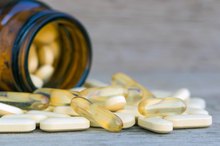The website, Healthy Women states that heavy menstrual bleeding (also called menorrhagia) is defined as soaking a pad and/or tampon every hour during each menstrual cycle. According to Dr. Marina Johnson, endocrinologist, a normal menstrual period lasts 2 to 7 days within a cycle that ranges from 21 to 35 days. When bleeding occurs between periods, or is longer or heavier than usual, this is called abnormal or irregular bleeding. There are various causes of irregular bleeding, but the most common is a hormone imbalance, either too much or too little of certain hormones. Vitamin K, iron, vitamin C, vitamin A, vitamin B and vitamin D can help alleviate heavy menstrual bleeding.
Vitamin K
According to the website, Alternative Doctor, vitamin K is best known for its role in helping blood clot properly and in preventing excessive bleeding. Vitamin K can also be used to stop heavy menstrual bleeding. Organic Facts states that vitamin K is a fat-soluble vitamin that can be found in the intestine. The recommended daily dose of vitamin K is 65 mcg.
- According to the website, Alternative Doctor, vitamin K is best known for its role in helping blood clot properly and in preventing excessive bleeding.
- Organic Facts states that vitamin K is a fat-soluble vitamin that can be found in the intestine.
Iron
Vitamins for the Menstrual Cycle
Learn More
According to the National Anemia Action Council, heavy menstrual bleeding is a common cause of iron deficiency anemia that affects millions of women every month. The University of Maryland states that there are two forms of supplemental iron: ferrous and ferric. Ferrous iron is better absorbed and is the preferred form of iron tablets. Ferrous iron is available in three forms: ferrous fumarate, ferrous sulfate, and ferrous gluconate. The recommended daily dose of elemental iron is 60 to 200 mg.
- According to the National Anemia Action Council, heavy menstrual bleeding is a common cause of iron deficiency anemia that affects millions of women every month.
- The University of Maryland states that there are two forms of supplemental iron: ferrous and ferric.
Vitamin C
Vitamin C can help ease heavy menstrual bleeding in some women. The website, Mother Nature states that excessive menstrual bleeding may be caused by fragile blood vessels. Vitamin C can strengthen those fragile blood vessels and make them less susceptible to damage. The recommended daily dose of vitamin C is 200 mg.
- Vitamin C can help ease heavy menstrual bleeding in some women.
- The website, Mother Nature states that excessive menstrual bleeding may be caused by fragile blood vessels.
Vitamin A
Vitamins for Varicose Veins
Learn More
Dr. Marilyn Glenville states that vitamin A is an antioxidant that can help protect cells against damage. Dr. Glenville states that vitamin A is needed to help red blood cell successfully replicate. A deficiency in vitamin A can cause heavy periods in some women. The recommended daily dose of vitamin A is 1 mg.
- Dr. Marilyn Glenville states that vitamin A is an antioxidant that can help protect cells against damage.
Vitamin B
According to Dr. Marilyn Glenville, vitamin B is beneficial for alleviating heavy periods. Vitamin B is used by the liver to convert excess estrogen into weaker and less dangerous forms. Dr. Glenville states that vitamin B6 is necessary for the production of prostaglandins, which reduces abnormal blood clotting. The recommended daily dose of vitamin B6 is 100 mg.
- According to Dr. Marilyn Glenville, vitamin B is beneficial for alleviating heavy periods.
Vitamin D
According to Quips and Tips for Couples Coping with Infertility, vitamin D alleviates heavy menstrual bleeding by balancing hormones. Vitamin D is also vital in breast, colon, ovarian and prostate cancer prevention. The best way to get an adequate amount of vitamin D is to spend at least 10 minutes in the sun about 2 to 3 times a week.
Related Articles
References
- Holick MF, Gordon CM. Patient Guide to Vitamin D Deficiency. The Journal of Clinical Endocrinology & Metabolism. 2011;96(7):1-2. doi:10.1210/jcem.96.7.zeg33a
- Sunyecz JA. The use of calcium and vitamin D in the management of osteoporosis. Ther Clin Risk Manag. 2008;4(4):827-836. doi:10.2147/tcrm.s3552
- Giovannucci E, Liu Y, Hollis BW, Rimm EB. 25-hydroxyvitamin D and risk of myocardial infarction in men: a prospective study. Arch Intern Med. 2008;168(11):1174-1180. doi:10.1001/archinte.168.11.1174
- Gorham ED, Garland CF, Garland FC, et al. Optimal vitamin D status for colorectal cancer prevention: a quantitative meta analysis. Am J Prev Med. 2007;32(3):210-216. doi:10.1016/j.amepre.2006.11.004
- Lappe JM, Travers-Gustafson D, Davies KM, Recker RR, Heaney RP. Vitamin D and calcium supplementation reduces cancer risk: results of a randomized trial. The American Journal of Clinical Nutrition. 2007;85(6):1586-1591. doi:10.1093/ajcn/85.6.1586
- Prentice RL, Pettinger MB, Jackson RD, et al. Health risks and benefits from calcium and vitamin D supplementation: Women’s Health Initiative clinical trial and cohort study. Osteoporos Int. 2013;24(2):567-580. doi:10.1007/s00198-012-2224-2
- Urashima M, Segawa T, Okazaki M, Kurihara M, Wada Y, Ida H. Randomized trial of vitamin D supplementation to prevent seasonal influenza A in schoolchildren. Am J Clin Nutr. 2010;91(5):1255-1260. doi:10.3945/ajcn.2009.29094
- Salehpour A, Hosseinpanah F, Shidfar F, et al. A 12-week double-blind randomized clinical trial of vitamin D₃ supplementation on body fat mass in healthy overweight and obese women. Nutr J. 2012;11:78. doi:10.1186/1475-2891-11-78
- Carrillo AE, Flynn MG, Pinkston C, et al. Impact of vitamin D supplementation during a resistance training intervention on body composition, muscle function, and glucose tolerance in overweight and obese adults. Clin Nutr. 2013;32(3):375-381. doi:10.1016/j.clnu.2012.08.014
- Marcinowska-Suchowierska E, Kupisz-Urbańska M, Łukaszkiewicz J, Płudowski P, Jones G. Vitamin D Toxicity-A Clinical Perspective. Front Endocrinol. 2018;9:550. doi:10.3389/fendo.2018.00550
- Ross AC, Manson JE, Abrams SA, et al. The 2011 report on dietary reference intakes for calcium and vitamin D from the Institute of Medicine: what clinicians need to know. J Clin Endocrinol Metab. 2011;96(1):53-58. doi:10.1210/jc.2010-2704
- Bouillon R, Van Schoor NM, Gielen E, et al. Optimal vitamin D status: a critical analysis on the basis of evidence-based medicine. J Clin Endocrinol Metab. 2013;98(8):E1283-E1304. doi:10.1210/jc.2013-1195
- American Academy of Dermatology. Position Statement of Vitamin D. 2010.
- Taksler GB, Cutler DM, Giovannucci E, Keating NL. Vitamin D deficiency in minority populations. Public Health Nutr. 2015;18(3):379-391. doi:10.1017/S1368980014000457
- Holick MF, Binkley NC, Bischoff-Ferrari HA, et al. Evaluation, treatment, and prevention of vitamin D deficiency: an Endocrine Society clinical practice guideline. J Clin Endocrinol Metab. 2011;96(7):1911-1930. doi:10.1210/jc.2011-0385
- Cannell JJ, Vieth R, Umhau JC, et al. Epidemic Influenza and Vitamin D. Epidemiol Infect. 2006; 134:1129-40.
- Carrillo AE1, Flynn MG, Pinkston C, Markofski MM, Jiang Y, Donkin SS, Teegarden D. Impact of Vitamin D Supplementation During a Resistance Training Intervention on Body Composition, Muscle Function, and Glucose Tolerance in Overweight and Obese Adults. Clin Nutr. 2013 Jun;32(3):375-81. doi: 10.1016/j.clnu.2012.08.014. Epub 2012 Aug 31.
- Ginde AA, Mansbach JM, Camargo CA, Jr. Association Between Serum 25-Hydroxyvitamin D Level and Upper Respiratory Tract Infection in the Third National Health and Nutrition Examination Survey. Arch Intern Med. 2009; 169:384-90.
- Giovannucci E, Liu Y, Hollis BW, Rimm EB. 25-hydroxyvitamin D and Risk of Myocardial Infarction in Men: a Prospective Study. Arch Intern Med. 2008; 168:1174-80.
- Gorham ED, Garland CF, Garland FC, Grant WB, Mohr SB, Lipkin M, Newmark HL, Giovannucci E, Wei M, Holick MF. Optimal Vitamin D Status for Colorectal Cancer Prevention: a Quantitative Meta-analysis. Am J Prev Med. 2007 Mar;32(3):210-6.
- Heaney, Robert P. “The Vitamin D Requirement in Health and Disease.” The Journal of Steroid Biochemistry & Molecular Biology 97 (2005):13-9.
- Holick MF. Vitamin D. In: Shils M, Olson J, Shike M, Ross AC, ed. Modern Nutrition in Health and Disease, 9th ed. Baltimore: Williams and Wilkins, 1999.
- National Institutes of Health Office of Dietary Supplements. Vitamin D: Dietary Supplement Fact Sheet. University of Ottawa Evidence-based Practice Center. Effectiveness and Safety of Vitamin D in Relation to Bone Health. Agency for Healthcare Research and Quality. Aug 2007: 07-E013.
- Salehpour A1, Hosseinpanah F, Shidfar F, Vafa M, Razaghi M, Dehghani S, Hoshiarrad A, Gohari M. A 12-week Double-blind Randomized Clinical Trial of Vitamin D₃ Supplementation on Body Fat Mass in Healthy Overweight and Obese Women. Nutr J. 2012 Sep 22;11:78. doi: 10.1186/1475-2891-11-78.
- Urashima M, Segawa T, Okazaki M, Kurihara M, Wada Y, Ida H. Randomized Trial of Vitamin D Supplementation to Prevent Seasonal Influenza A in Schoolchildren. Am J Clin Nutr. 2010 91:1255-60. Epub 2010 Mar 10.
- Wilkins, Consuelo H. and Yvette I. Sheline, et al. “Vitamin D Deficiency Is Associated with Low Mood and Worse Cognitive Performance in Older Adults.” American Journal of Geriatric Psychiatry 14 (2006): 1032-40.
Writer Bio
R. Y. Langham served as a senior writer for "The Herald" magazine from 1996-99. Langham holds a Bachelor of Arts in English from Fisk University, a Master of Science in marriage and family therapy from Trevecca Nazarene University and a Ph.D in family psychology from Capella University. Dr. R.Y. Langham published her first psychological thriller in September 2011. It can be purchased on Amazon.com, Barnes&Noble.com and Lulu.com.









